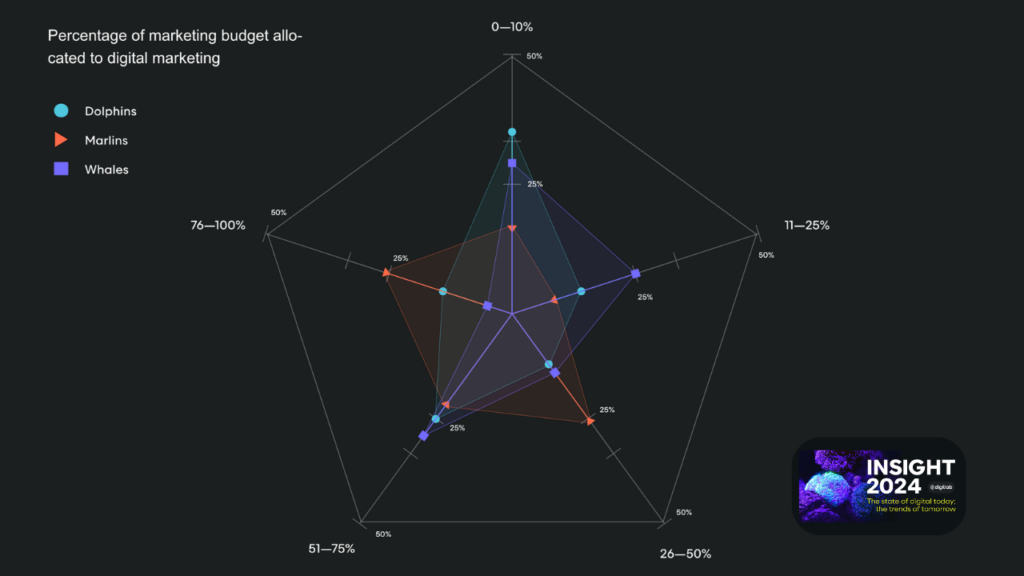In the dynamic landscape of digital marketing, decoding budget signals and budget allocation serves as a powerful sign of a company’s strategic priorities and approach.
The way businesses allocate their resources in the digital space can unveil insights into their goals, priorities, and the overall direction of their marketing strategy.
We explore the landscape of marketing budget allocation below.
Shifting marketing budgets
Marketing budgets across businesses show different degrees of increase.
Larger enterprises, often likened to whales, display a more polarised approach, either investing heavily or making large cuts.
In contrast, mid-sized businesses, referred to as marlins, and smaller businesses, likened to dolphins, tend to adopt a more cautious and balanced approach when adjusting their budgets.
Whales: High Investment Tensions
Enterprises with an annual revenue of R100M or more, often called ‘Whales,’ show a more assertive marketing approach.
Among them, 56.66% have increased their marketing budgets, with 33.33% reporting a significant boost and 18.33% experiencing a substantial decrease.
While the majority trend suggests that whales heavily invest in marketing to uphold their market position, the presence of a notable 18.33% outlier indicates that, during challenging economic times, companies may grapple with striking a balance between marketing demands and resource constraints.
Marlins: Stable Growth
Businesses falling into the ‘Marlin’ category (R10M to R99.9M) demonstrate a balanced approach to their marketing budgets.
A majority (63.04%) reported increases, with a large portion favouring slight increments.
This shows us that Marlins adopt a cautiously optimistic stance, recognising the value of slightly boosting their marketing spend.
However, the ‘Marlin’ category also reported a notable 10.87% of respondents who significantly decreased their marketing budget, suggesting an awareness of economic challenges like those faced by larger organisations.
Dolphins: Considered Consistency
Small businesses with an annual income under R10M, falling into the ‘Dolphin’ category, generally show a tendency to sustain their marketing budgets.
Among them, 49.52% reported an increase, while 36.54% noted no change.
The inclination for smaller businesses to be cautious in their marketing investments may stem from concerns related to tighter cash flows or uncertainties about returns on investment.

Decoding budget signals through prioritising digital in budgets
Budget allocation reveal distinct business priorities.
Mid-sized firms show adaptability, while larger companies lean towards conservatism, often considering diversification.
Small businesses showcase notable potential in their budgetary strategies.
The growth of digital marketing is evident, yet its adoption differs across different business sizes.
Whales: Conservative
Popular enterprises show a reserved approach to marketing, evident in their budget allocation.
They often designate 0-10% and 51-75% of their budget to digital marketing, showcasing a blend of traditional and digital methods.
The reluctance to heavily invest in digital marketing, exemplified by a mere 4.17% allocation in the 76-100% range, may come from a well-established brand presence or a diversified marketing strategy.
This pattern implies that big businesses see digital marketing as supplementary rather than a primary avenue, reflecting a measured and cautious approach.
Marlins: Adaptable
Mid-sized businesses seem to be at a crucial juncture, as the data indicates a substantial inclination towards digital marketing—potentially to compete with larger counterparts or establish dominance over smaller entities.
The noteworthy commitment of over half their budget to digital platforms, observed in both the 26-50% and 76-100% categories, serves as an outlier emphasizing their commitment to leveraging modern marketing avenues.
This trend could signify their belief in digital platforms as tools for levelling the competition or as central to their growth strategies.
Dolphins: Cautious
Small businesses show a cautious yet intriguing stance toward digital marketing.
While a majority appear hesitant, allocating less than 10% of their budget to digital, a large portion demonstrates ambition by investing between 51-75%.
This distribution seems to mirror the delicate balancing act between budget constraints and the allure of digital’s promises, such as increased reach and cost-effectiveness.
The pronounced dip in the 26-50% range stands out as a notable outlier, indicating that small businesses are either minimally involved or very committed, with less remaining in a middle-ground position.

The shift towards digital marketing is an undeniable reality, yet the strategies businesses employ to navigate this landscape can differ a lot.
The budgetary commitments across various business sizes show distinct approaches and potential focus areas, showing a mix of ambition, caution, and adherence to tradition.
Whether going for an aggressive, measured, or cautiously optimistic approach, businesses are collectively striving to carve out a unique digital presence.
Discover the trends shaping digital in 2024
Conducted in collaboration with the Digital Marketing Conference, our 16-question survey on the current state of digital provides valuable insights into prevailing marketing strategies and industry trends.
The Insight 2024: The State of Digital Report offers expert insights from digital marketing professionals and analysts, a comprehensive analysis of key trends derived from survey data and expert articles, and strategic guidance to inform smart decision-making.
We dive into critical questions that touch on what’s currently effective in digital marketing, how to authentically embody customer-centricity, effective data utilisation, the impact of various digital channels, budgeting strategies, the importance of adaptability and innovation in the face of economic volatility, the role of marketing technology (including analytics, CRM, and automation), the transformative power of generative AI, and consumer insights on messaging, user-friendly interfaces, and the influence of platforms like TikTok.






